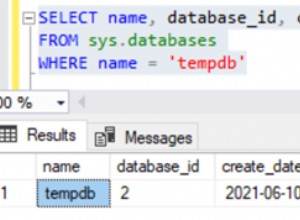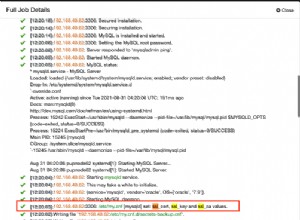O código como escrito nem chegou a salvar um arquivo para mim. Parece haver alguns problemas. Não tenho certeza se este é o código real ou algumas coisas se perderam na pasta de cópia. No entanto, com base no que você tem:
Um grande problema é que você nunca se conecta ao banco de dados em seu código com connection.connect().
O código que você deseja executar uma vez conectado deve estar dentro do callback connection.connect(). por exemplo.
connection.connect(function (err, empty) {
if (err)
throw new Error ('Panic');
// if no error, we are off to the races...
}
No entanto, mesmo se você refatorar rapidamente seu código para envolver suas últimas linhas dentro desse retorno de chamada de conexão, você ainda terá problemas, porque está destruindo a conexão antes que as várias chamadas SQL sejam feitas, então você vai querer mover o código em algum tipo de retorno de chamada final.
Mesmo depois de fazer isso, você ainda terá um arquivo vazio, porque você está chamando save_backup de seu retorno de chamada 'SHOW TABLES' em vez de tê-lo preenchido por meio do retorno de chamada interno, onde você obtém a instrução CREATE TABLE e preenche o propriedade de backup.
Esta é a reescrita mínima do seu código que fará o que você pretende. Uma coisa importante a notar é o "contador" que gerencia quando escrever o arquivo e fechar a conexão. Eu faria outras alterações se fosse meu, incluindo:
- Usando 'self' em vez de 'me'
- Usando um loop numérico for em vez da sintaxe for (... in ...)
- Ter meus próprios retornos de chamada se enquadra na convenção de nó de (err, coisas)
- Uma mudança mais substancial é que eu reescreveria isso para usar promessas, pois isso pode poupar algum sofrimento com a confusão inerente aos retornos de chamada profundamente aninhados. Pessoalmente, gosto da biblioteca Q, mas há várias opções aqui.
Espero que isso tenha ajudado.
var mysql_backup = function(){
this.backup = '';
this.mysql = require('mysql');
this.init = function(){
this.connection = this.mysql.createConnection({
user : 'root',
password : 'root',
database : 'test'
});
};
this.query = function(sql, callback) {
this.connection.query(sql, function (error, results, fields) {
if (error) {
throw error;
}
if (results.length > 0) {
callback(results);
}
});
};
this.get_tables = function(callback){
var counter = 0;
var me = this;
this.query('SHOW TABLES',
function(tables) {
for (table in tables){
counter++;
me.query(
'SHOW CREATE TABLE ' + tables[table].Tables_in_mvc,
function(r){
for (t in r) {
me.backup += "DROP TABLE " + r[t].Table + "\n\n";
me.backup += r[t]["Create Table"] + "\n\n";
}
counter--;
if (counter === 0){
me.save_backup();
me.connection.destroy();
}
}
)
}
});
};
this.save_backup = function(){
var fs = require('fs');
fs.writeFile("./backup_test.txt", this.backup, function(err) {
if(err) {
console.log(err);
} else {
console.log("The file was saved!");
}
});
}
};
var db = new mysql_backup;
db.init();
db.connection.connect(function (err){
if (err) console.log(err);
db.get_tables(function(x){;});
});
Atualização:Se você está curioso, aqui está uma implementação muito comentada usando promessas. Observe que, sem os comentários explicando as funções da biblioteca de promessas Q, ela é um pouco mais curta que a versão original e também oferece tratamento de erros mais abrangente.
var MysqlBackup = function(connectionInfo, filename){
var Q = require('q');
var self = this;
this.backup = '';
// my personal preference is to simply require() inline if I am only
// going to use something a single time. I am certain some will find
// this a terrible practice
this.connection = require('mysql').createConnection(connectionInfo);
function getTables(){
// return a promise from invoking the node-style 'query' method
// of self.connection with parameter 'SHOW TABLES'.
return Q.ninvoke(self.connection,'query', 'SHOW TABLES');
};
function doTableEntries(theResults){
// note that because promises only pass a single parameter around,
// if the 'denodeify-ed' callback has more than two parameters (the
// first being the err param), the parameters will be stuffed into
// an array. In this case, the content of the 'fields' param of the
// mysql callback is in theResults[1]
var tables = theResults[0];
// create an array of promises resulting from another Q.ninvoke()
// query call, chained to .then(). Note that then() expects a function,
// so recordEntry() in fact builds and returns a new one-off function
// for actually recording the entry (see recordEntry() impl. below)
var tableDefinitionGetters = [];
for (var i = 0; i < tables.length ; i++){
// I noticed in your original code that your Tables_in_[] did not
// match your connection details ('mvc' vs 'test'), but the below
// should work and is a more generalized solution
var tableName = tables[i]['Tables_in_'+connectionInfo.database];
tableDefinitionGetters.push(Q.ninvoke(self.connection, 'query', 'SHOW CREATE TABLE ' + tableName)
.then(recordEntry(tableName)) );
}
// now that you have an array of promises, you can use Q.allSettled
// to return a promise which will be settled (resolved or rejected)
// when all of the promises in the array are settled. Q.all is similar,
// but its promise will be rejected (immediately) if any promise in the
// array is rejected. I tend to use allSettled() in most cases.
return Q.allSettled(tableDefinitionGetters);
};
function recordEntry (tableName){
return function(createTableQryResult){
self.backup += "DROP TABLE " + tableName + "\n\n";
self.backup += createTableQryResult[0][0]["Create Table"] + "\n\n";
};
};
function saveFile(){
// Q.denodeify return a promise-enabled version of a node-style function
// the below is probably excessively terse with its immediate invocation
return (Q.denodeify(require('fs').writeFile))(filename, self.backup);
}
// with the above all done, now you can actually make the magic happen,
// starting with the promise-return Q.ninvoke to connect to the DB
// note that the successive .then()s will be executed iff (if and only
// if) the preceding item resolves successfully, .catch() will get
// executed in the event of any upstream error, and finally() will
// get executed no matter what.
Q.ninvoke(this.connection, 'connect')
.then(getTables)
.then(doTableEntries)
.then(saveFile)
.then( function() {console.log('Success'); } )
.catch( function(err) {console.log('Something went awry', err); } )
.finally( function() {self.connection.destroy(); } );
};
var myConnection = {
host : '127.0.0.1',
user : 'root',
password : 'root',
database : 'test'
};
// I have left this as constructor-based calling approach, but the
// constructor just does it all so I just ignore the return value
new MysqlBackup(myConnection,'./backup_test.txt');




